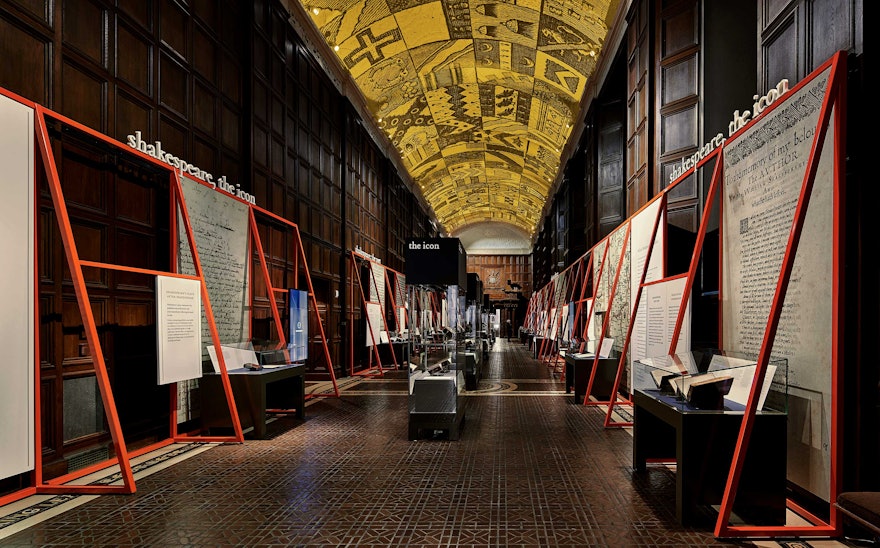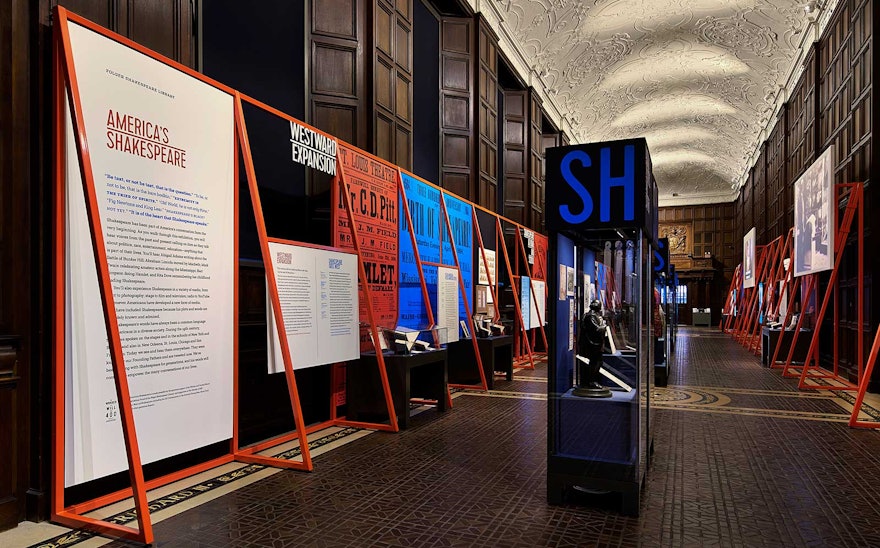Four centuries after his death, William Shakespeare endures as the most famous author in the world and quite possibly the greatest writer in the English language. Almost everything we know about him comes from his legacy of plays, poets and sonnets, but a glimpse of his life and rise to fame can be seen in the contemporary reactions to his work and in the everyday documents, contracts and other paperwork that recorded his existence. Pentagram has designed Shakespeare, Life of an Icon, a new exhibition at the Folger Shakespeare Library in Washington, DC that creates a portrait of Shakespeare as told through 50 of the most important manuscripts and printed works related to his life and career. The show kicks off “The Wonder of Will,” a yearlong celebration at the Folger that commemorates the 400th anniversary of Shakespeare’s death (1616) with a series of special events, exhibitions, performances and other programming.
The Folger houses the world's largest collection of Shakespeare-related material, and many of the documents in Shakespeare, Life of an Icon are on public display for the first time. The designers worked closely with Folger curator Heather Wolfe to develop a design that would tell a compelling story through these objects. There will never be a photograph of Shakespeare or a recording of his voice, but the exhibition assembles an intimate perspective of "the Bard" through an array of printed items that includes, among others, the first mention of Shakespeare as a playwright, some of his first plays to be printed, deeds recording his real estate purchases, drafts of the heraldic grant of arms that he helped his father obtain, and diary entries by others about seeing his plays and buying his works, as well as the first edition of his collected works, the 1623 First Folio.
For the designers, the challenge was to create an engaging and immersive environment built around books and papers displayed in vitrines. Another challenge was the Folger space itself: Designed by the architect Paul Cret (who also designed the original Barnes Foundation building in Merion, Pennsylvania), the 1932 building houses its main gallery in the Great Hall, an expansive Tudor-inspired interior of dark oak panels offset by a vaulted white ornamental ceiling. Long but not wide, the 2,827 sq ft gallery stretches for a block (between 2nd Street SE and 3rd Street SE) and rises to a double-story height, potentially dwarfing anything displayed inside.
Inspired by stagecraft, the exhibition design uses a theatrical approach to transform the dramatic historical setting. A structure of scaffolding that suggests the framework of a stage set has been installed around the walls of the gallery. The objects are displayed in the Library's existing vitrines, which nest within the structure. Made of bright red steel tubing, the 10 1/2-foot-tall framework scales up the rare documents with enlargements of details that were specially photographed for the massive reproductions.
The magnification of the panels is echoed in an animated projection on the ceiling of the Great Hall. Called “The Cloud,” the dynamic installation was specially created for the anniversary. Working with historic texts and visual sources, the designers developed a presentation that reflects on themes within Shakespeare’s life and work. Texts, patterns, manuscripts and heraldry are woven into the historic “strapwork” ornamentation on the ceiling.
The projection is seamlessly displayed across the ceiling by nine projectors pointing upwards from the gallery floor. Running approximately 40 minutes in length, the entire sequence is comprised of eight distinct segments. The series begins with a tracing of the coat of arms embedded in the plasterwork to form decorative patterns; other segments use imagery primarily taken from Thomas Trevelyon’s Miscellany (1608) a manuscript of folios that contains texts and images from books, woodcuts and engravings from Shakespeare’s time, as well as other sources. In a typographic segment, the titles of Shakespeare’s plays spelled as they appeared in the First Folio, with lettering based on hand-drawn letters used by Thomas Trevelyon in his manuscript. Another sequence shows multiple versions of William Shakespeare’s name as taken from sources printed during his lifetime.
Pentagram also designed America's Shakespeare, a subsequent exhibition in the Folger's yearlong celebration.

